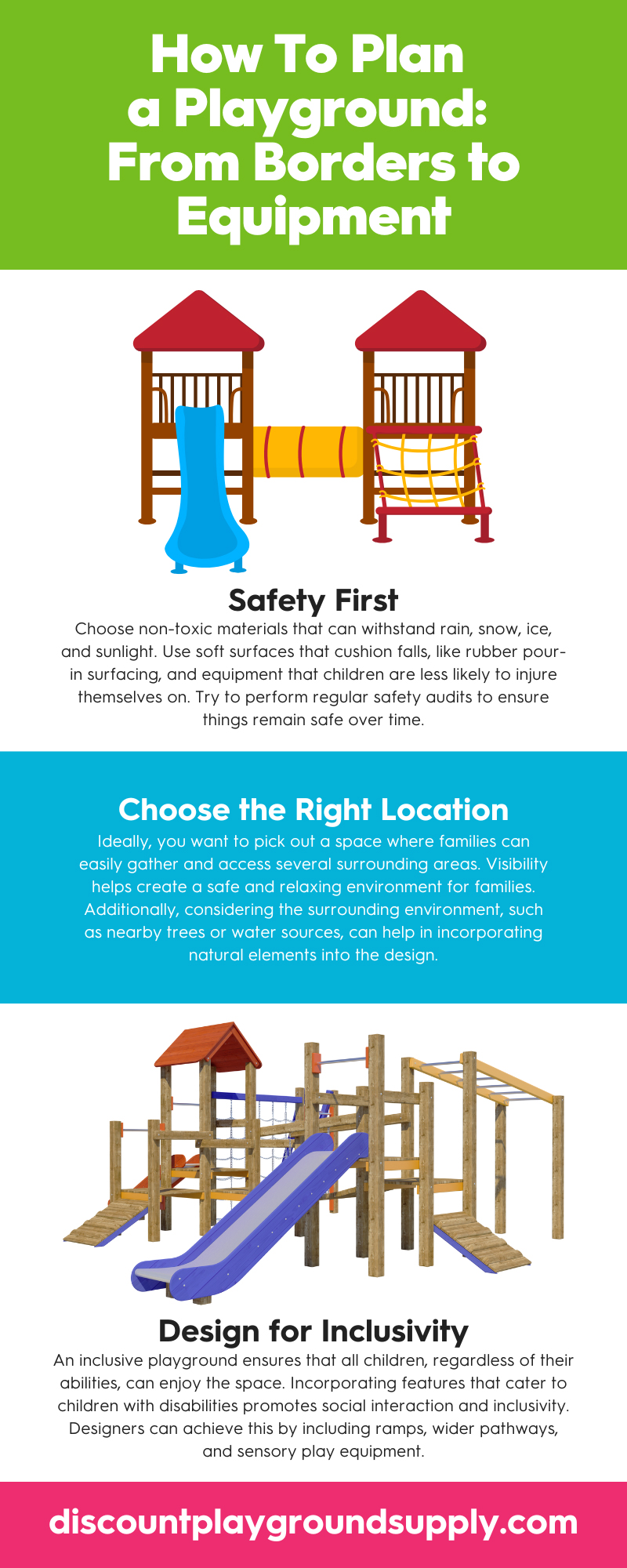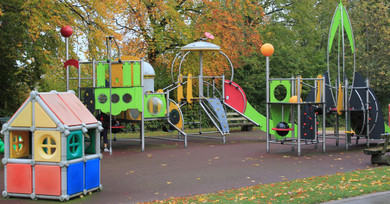Creating a playground is more than just installing a few swings and slides. You need to carefully plan out a wide variety of details such as the playground’s aesthetics, functionality, safety, and more.
Knowing how to plan a playground from borders to equipment requires a careful understanding of how parks work, what sort of things visitors are looking for, and how to craft a safe, enjoyable environment. Discount Playground Supply knows each of the factors that go into creating an exceptional playground. Continue reading to understand the steps you must take to design a new playground and overcome a few of the common hurdles.
Safety First
You should always have safety at the top of your list when designing a playground. Ensuring that the playground is safe for children involves several key considerations.
Choose non-toxic materials that can withstand rain, snow, ice, and sunlight. Use soft surfaces that cushion falls, like rubber pour-in surfacing, and equipment that children are less likely to injure themselves on. Try to perform regular safety audits to ensure things remain safe over time.
Designers must consider factors such as height restrictions, spacing between equipment, and age-appropriate features. Install proper signage to help inform parents and visitors about any potential risks and the recommended age group for specific equipment.
Choose the Right Location
After picking the right spot, nearly every other decision that you make will need to work within your established plot of land. You need to consider all factors like the location’s accessibility features, visibility, and existing landscaping.
Ideally, you want to pick out a space where families can easily gather and access several surrounding areas. Visibility helps create a safe and relaxing environment for families. Additionally, considering the surrounding environment, such as nearby trees or water sources, can help in incorporating natural elements into the design.
If you’re planning a park in a more urban area, you may have more trouble finding an open spot. However, you should still aim to place the park in a space where the community can appreciate its presence.
Designers should also consider proximity to schools and residential areas, which can impact how often visitors use the playground. Choosing the right location will help attract more visitors and help ensure that your park is a successful project.
Design for Inclusivity
An inclusive playground ensures that all children, regardless of their abilities, can enjoy the space. Incorporating features that cater to children with disabilities promotes social interaction and inclusivity. Designers can achieve this by including ramps, wider pathways, and sensory play equipment.
Creating a playground that accommodates children with different needs involves thoughtful design and consultation with experts. You can gain valuable insight into some of these specific requirements by engaging with disability organizations and making the playground fun and inclusive for all children.
Select Age-Appropriate Equipment
When figuring out how to plan a playground, selecting the right borders and equipment will determine a successful design. You want to choose equipment that various age groups can use to try and maximize enjoyment. Playgrounds typically cater to children in different age brackets, such as toddlers, preschoolers, and school-aged kids. Each age group has unique developmental needs and play preferences.
You can use low slides or small climbing structures to help toddlers with basic motor skills. Preschoolers will benefit from interactive equipment that promotes creativity, social interaction, and learning, such as a spinning tic-tac-toe board. School-aged children will prefer tall slides, climbing walls, and monkey bars that challenge their mental and physical skills.
To keep children safe inside the play area, don’t forget to plan for plastic playground borders. Discount Playground Supply’s selection of playground borders is durable and versatile. With these durable components in place, children can roam freely around the playground.
Embrace Long-Lasting Equipment
A well-maintained playground supports a safe, enjoyable environment for children. Durability is a key factor in reducing maintenance costs and ensuring the playground remains. A very important part of this is to select high-quality materials that withstand weather conditions and general wear and tear.
Adhere to a Strict Maintenance Schedule
Every durable playground equipment piece needs cleaning or repairing from time to time. Designers should develop a maintenance plan that outlines regular inspections and repairs. A maintenance plan allows you to promptly address issues like damaged equipment or worn-out surfaces. Incorporating easy-to-clean surfaces and vandalism-resistant materials can also contribute to the playground’s longevity.
Incorporate Natural Elements
Integrating natural elements into a playground design can enhance the aesthetic appeal and provide additional play opportunities. Elements such as trees, boulders, and water features provide children with a chance to interact with nature, fostering creativity and exploration.
You can design your park to highlight natural features and complement the traditional play equipment. For example, incorporating a rock wall alongside a climbing structure can provide varied challenges and encourage imaginative play.
Engage the Community
Community involvement is a large part of successful playground planning. Engaging with local residents, schools, and organizations can provide valuable insights and foster a sense of ownership. You can use community input to help identify the specific needs of local parents or kids and figure out what type of equipment or functions would best serve the members of the area.
Hosting workshops and design sessions allows community members to contribute ideas and feedback. This collaborative approach encourages buy-in and support, which can be crucial for fundraising and future maintenance efforts.
Design for Aesthetics
While functionality and safety are critical, aesthetics play a significant role in attracting visitors and creating a welcoming atmosphere. A visually appealing playground can inspire creativity and imagination in children, enhancing their overall experience.
Designers should consider the color scheme, layout, and thematic elements when planning the playground. Try to develop a cohesive design that reflects and enhances the surrounding environment and community and create something that has visual appeal without looking too out of place.
Evaluate Environmental Impact
Sustainability is becoming increasingly important in playground design. You should try to evaluate and minimize the potential environmental impacts of your park by selecting eco-friendly materials and implementing energy-efficient practices.
Choosing recycled materials for equipment and surfacing reduces waste and conserves resources. Implementing rainwater harvesting systems and solar lighting can further decrease the playground’s ecological footprint.
Implement Educational Features
Playgrounds can serve as valuable learning environments. Offering educational opportunities alongside physical play can stimulate curiosity and foster cognitive development in children.
Some of the popular options for these installations may include science stations, nature trails, and more interactive exhibits. You can tailor these elements to the interests and educational goals of the community like emphasizing local flowers or unique landmarks.
If you need a helping hand from a playground expert, consider choosing the playground equipment from Discount Playground Supply. We have a wide range of available products from to high-quality swing sets to plastic playground borders to enhance safety and fun at your playground.


